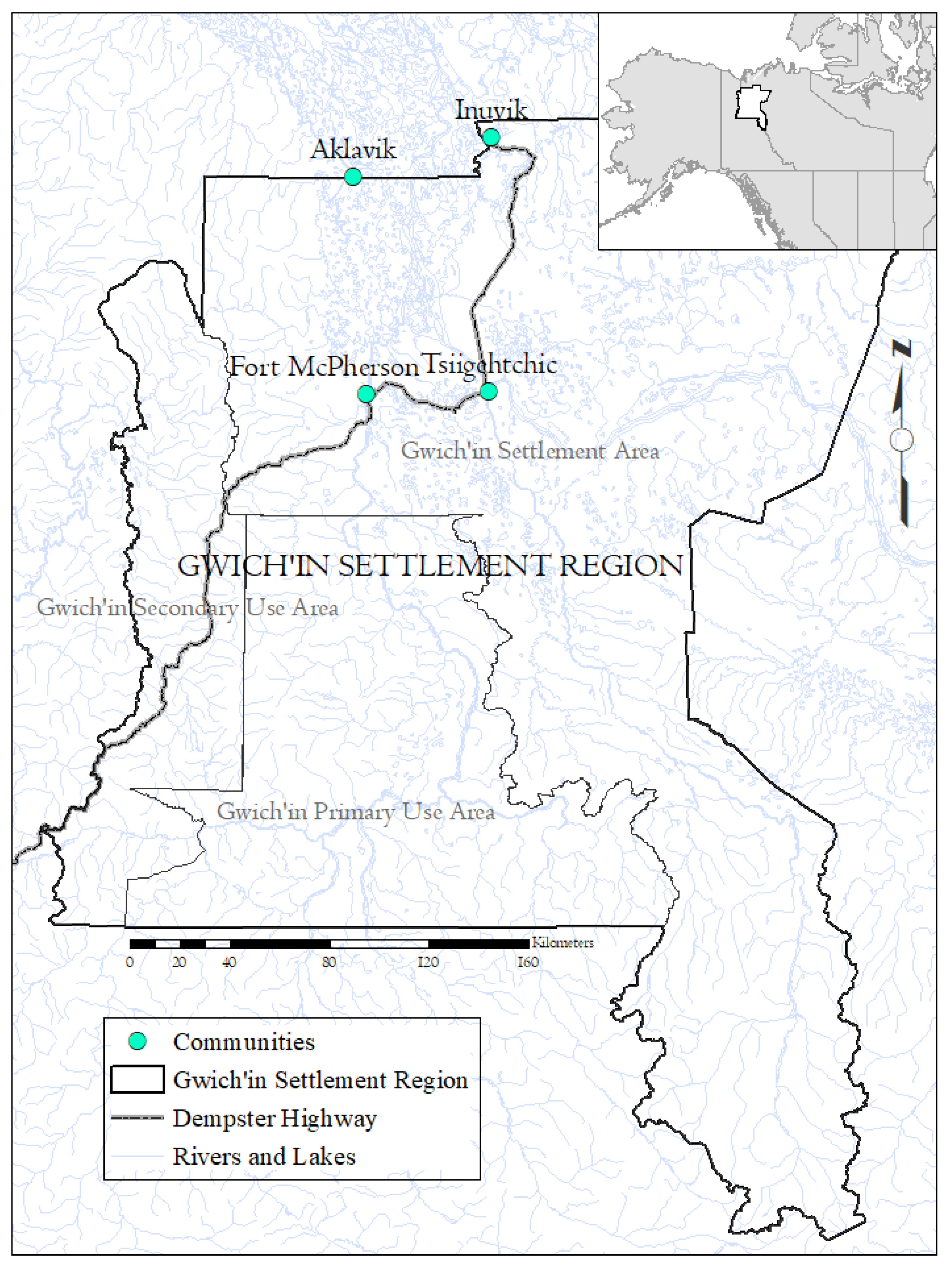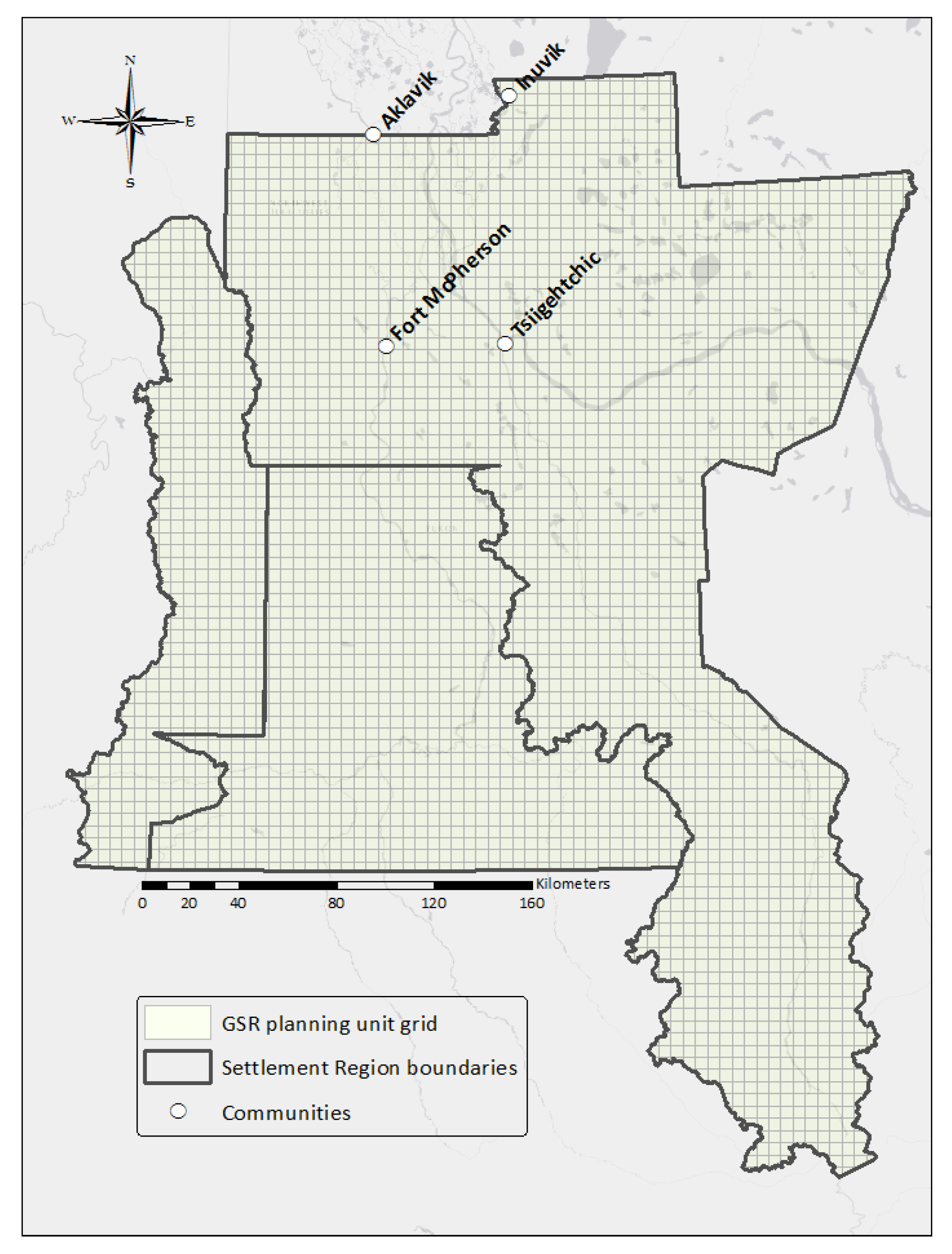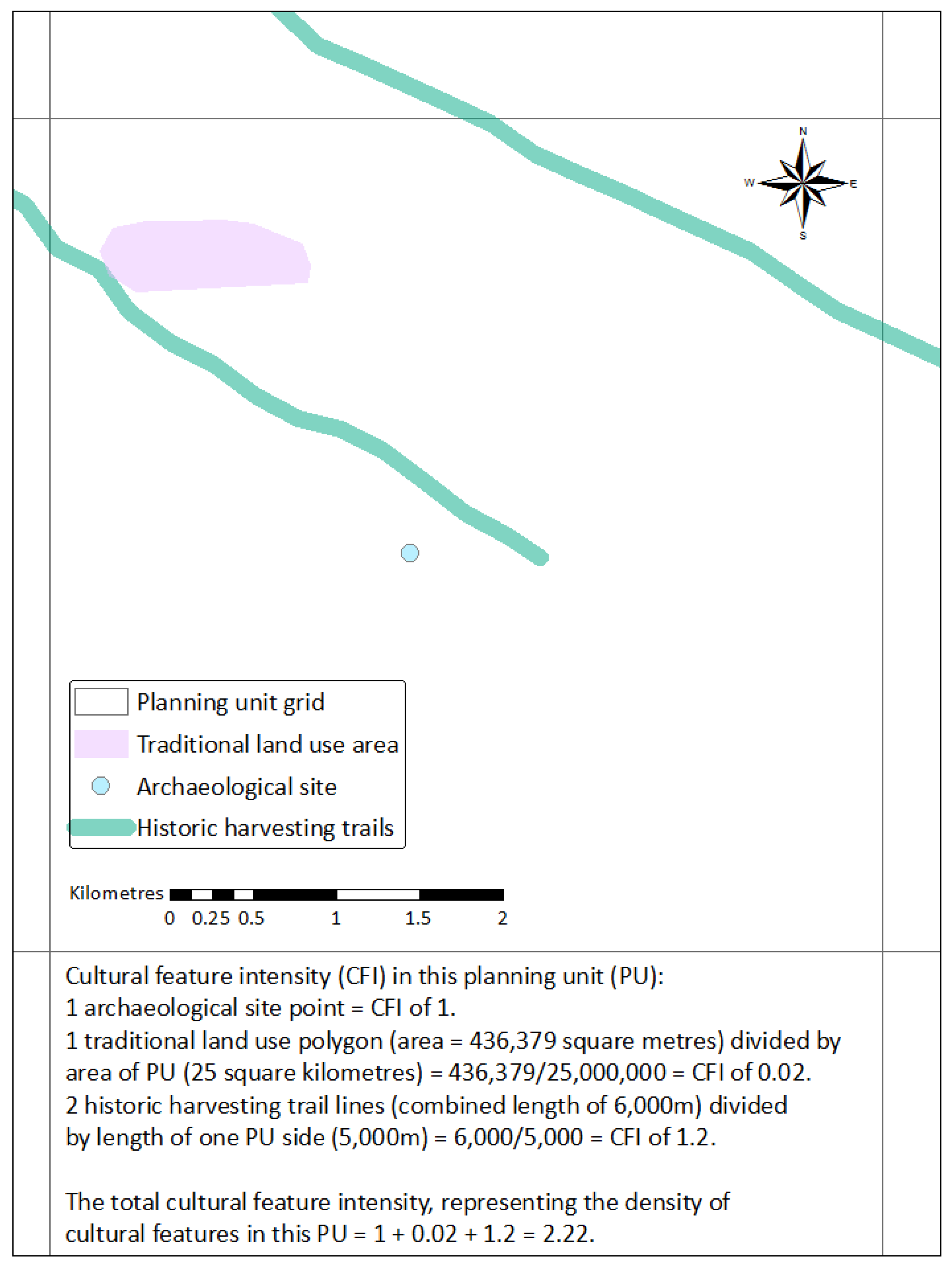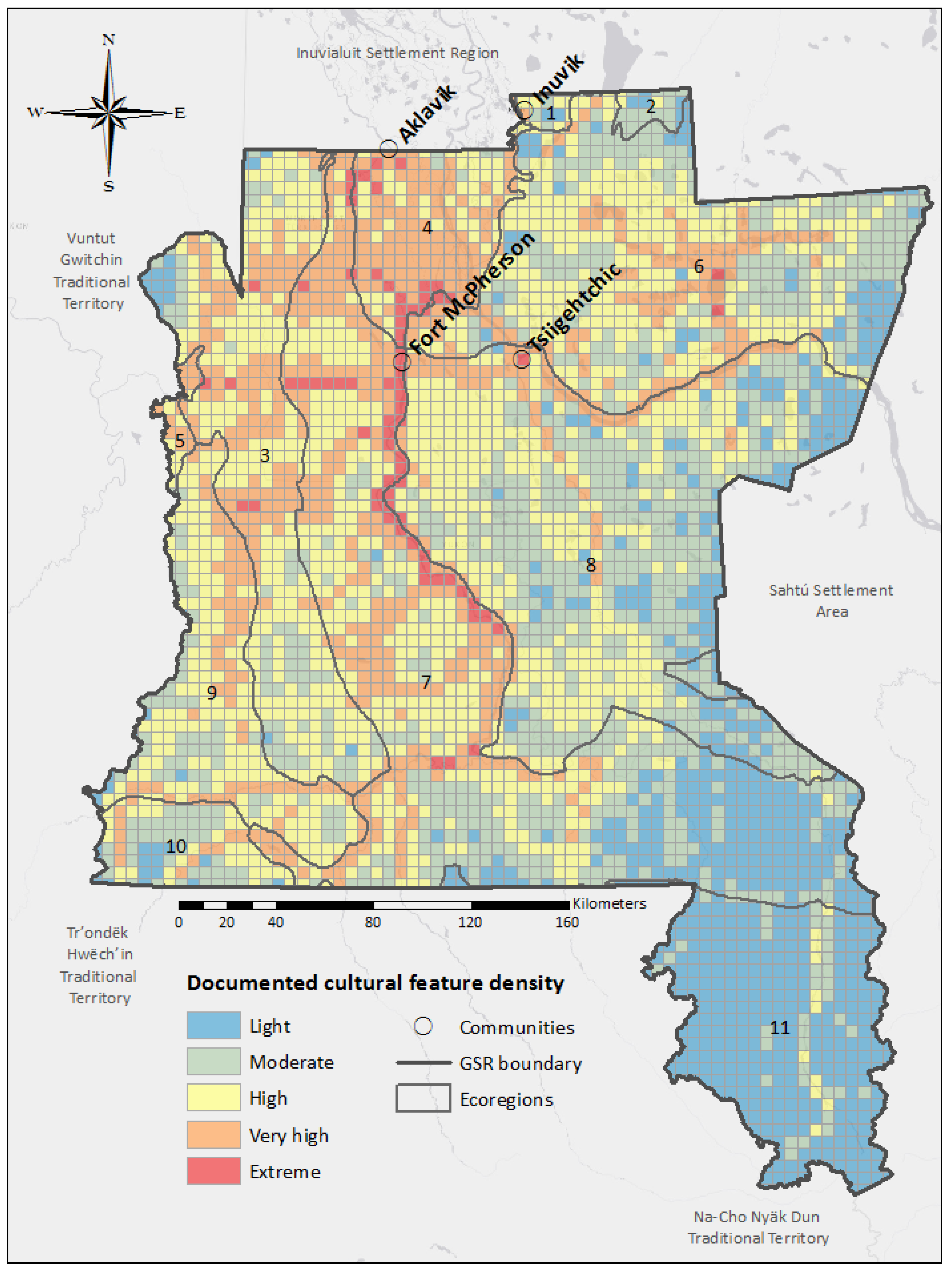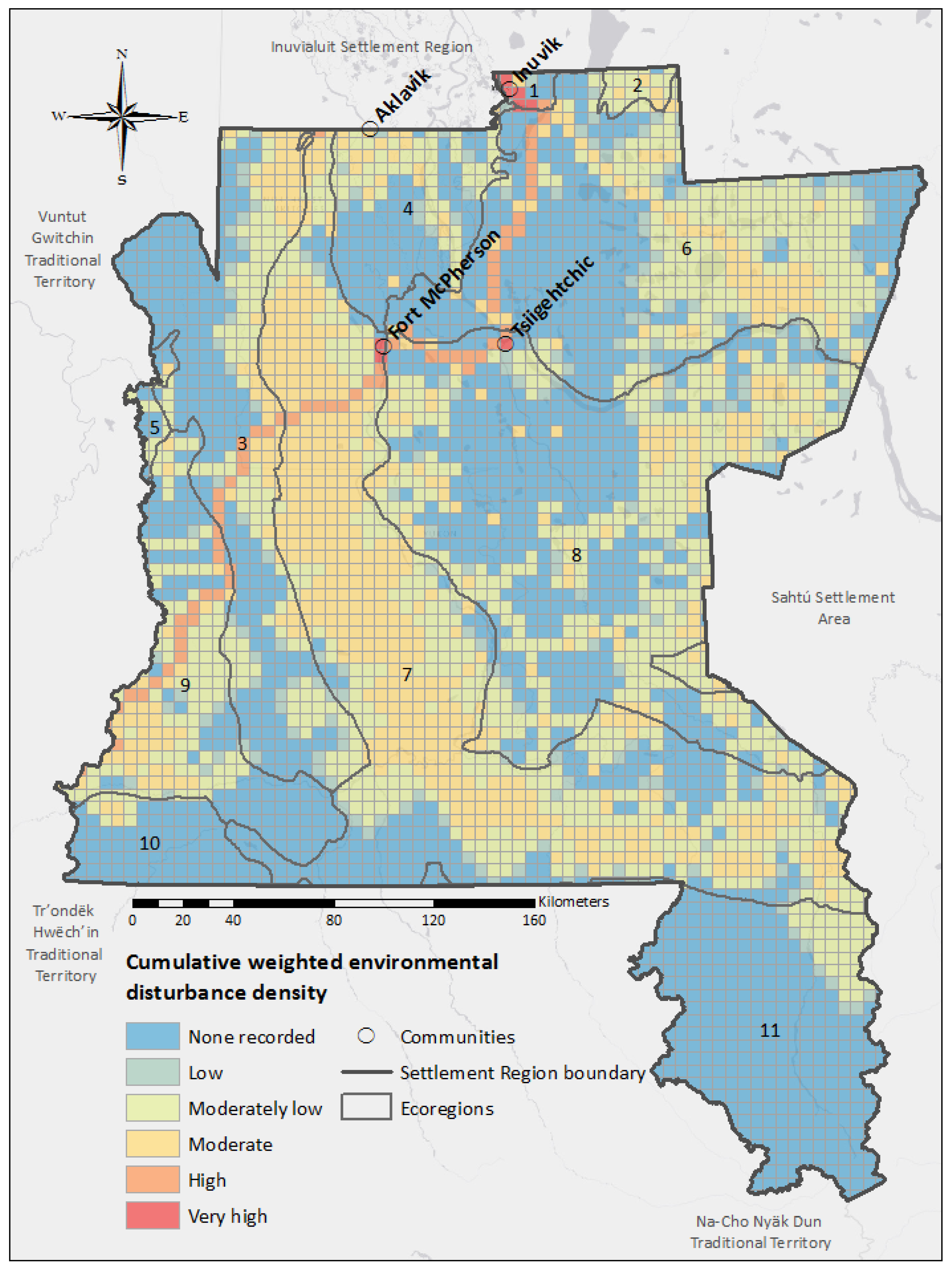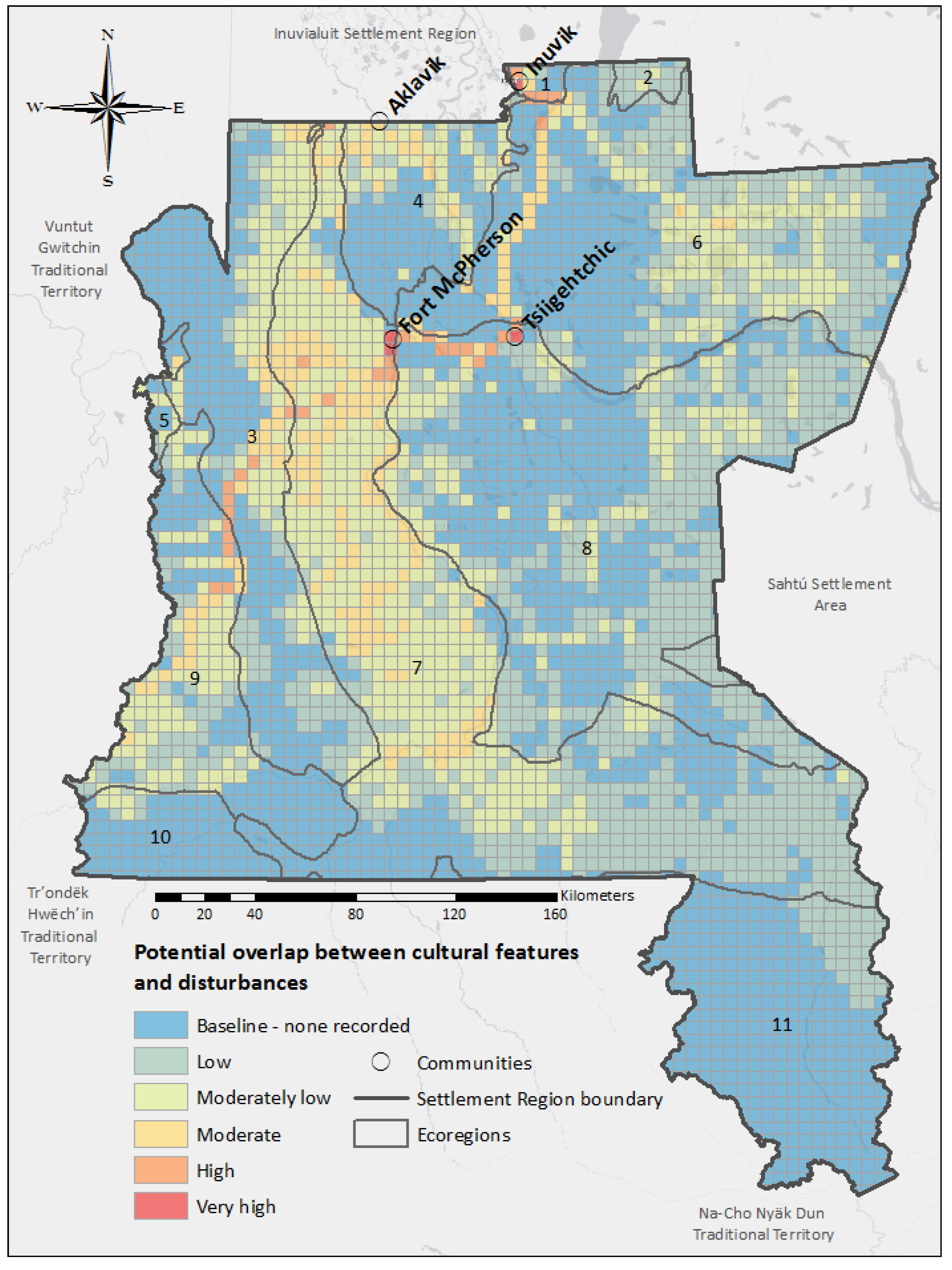1. Introduction
The combined effects of intensified natural and anthropogenic disturbances are altering the structure and function of global ecosystems [
1,
2], with the potential to significantly impact the land-based livelihoods of many Indigenous groups [
3,
4]. In the Arctic, where the climate is warming more rapidly than anywhere else on Earth [
5] and industrial development is expanding [
6,
7], changes to local livelihoods may be particularly severe [
8,
9]. Alongside the impacts of climate change to permafrost, vegetation, and hydrological conditions [
10,
11,
12], northern regions are experiencing development projects like oil and gas exploration and extraction, mining, and road construction [
13,
14,
15].
Incremental, compounding disturbances that can cause landscape and ecosystem change are often defined as cumulative impacts [
16,
17]. Over the past few decades, considerable effort has been devoted to assessing the cumulative impacts of natural and anthropogenic disturbances through studies examining existing or potential impacts of a specific development project [
18,
19], or the broader scale impacts of multiple stressors on regional ecosystems [
1,
20]. Accounting for cumulative environmental impacts is important because they can severely impair water quality, terrain stability, and animal habitat, and interact in unexpected ways [
21,
22,
23,
24].
Cumulative impacts can also affect culturally significant landscape features. Indigenous cultures across the circumpolar north rely on foods harvested from the land, and maintain strong connections with local landscapes through cultural features [
25,
26]. In northern ecosystems, cultural features and activities are so widespread that most regions are best described as cultural landscapes [
27,
28]. In this paper, we define cultural features as tangible and intangible landscape features that are important for subsistence harvesting (i.e., hunting, trapping, fishing, gathering) and well-being, and/or that are culturally important for land management and political, spiritual, religious, or educational reasons.
Since the early 1990s, there have been repeated calls for environmental assessments and cumulative impact studies that include impacts to the land use, livelihoods, and cultural traditions of Indigenous peoples [
29]. Despite multiple studies pointing to this gap and calling for the increased inclusion and recognition of cultural values and subsistence resources in cumulative impact assessments [
27,
30,
31,
32], most cumulative impacts research has focused primarily on ecological changes following disturbance (i.e., [
1,
17,
33]). Some studies have worked to address these gaps through collaborative approaches and methods that recognize cultural locations as valued ecosystem components [
20,
28,
30]. Despite these efforts, there are few quantitative, data-driven, regional analyses examining cumulative impacts affecting a variety of cultural features alongside ecological landscape components [
20,
34].
In this study, we explore the potential of spatial overlay analysis to quantify and map the potential overlap between environmental disturbances and cultural features in the Gwich’in Settlement Region (GSR). Areas of overlap identify places where cumulative impacts may damage, destroy, or alter cultural features, and impact cultural practices like subsistence harvesting and travel. Our analysis provides a snapshot of regional cumulative environmental impacts occurring in the Gwich’in Settlement Region, and details a planning tool that can be used by cultural and natural resource managers in the midst of rapid, regional changes.
Gwich’in Territory
Our study area is the Gwich’in Settlement Region, the portion of Gwich’in First Nation territory that is located in the northwestern Northwest Territories and the eastern reaches of Yukon Territory, Canada. This 90,379 km
2 area is divided into three sub-regions: The 56,935 km
2 Gwich’in Settlement Area (GSA) in the Northwest Territories, and the 21,988 km
2 Primary Use Area and 11,456 km
2 Secondary Use Area in Yukon Territory (
Figure 1) [
35]. The Primary and Secondary Use Areas overlap with the traditional territories of the Tr’ondëk Hwëch’in, Vuntut Gwitchin, and Na-Cho Nyäk Dun First Nations [
35]. The four Gwich’in cultural groups in the GSR include the Ehdiitat Gwich’in of Aklavik, the Nihtat Gwich’in in Inuvik, the Teetł’it Gwich’in of Teetł’it Zheh/Fort McPherson, and the Gwichya Gwich’in in Tsiigehtchic [
35].
Physically, this interior subarctic area lies near the tree line, hosting forest, woodland, upland tundra, and barren alpine areas, alongside thousands of rivers, lakes, and wetlands [
36]. The ecosystems in the GSR support diverse plant and animal communities [
37], and are interconnected by river systems including the Mackenzie (
Nagwichoonjik), Peel (
Teetł’it Gwinjik), and Arctic Red (
Tsiigehnjik). The Gwich’in travel by land and water throughout these territories, maintaining traditions of fishing, hunting, trapping, and gathering food and medicines from the land [
37,
38]. The land and water are vital to Gwich’in culture, and individual and community well-being [
37,
39]. Connections between people and place in Gwich’in territory have been well documented by mapping projects such as the Dene Mapping Project [
40] and numerous initiatives led by the Gwich’in Tribal Council Department of Cultural Heritage (i.e., [
41]).
4. Discussion
Cultural landscapes have been described as areas defined by intricate relationships between humans and the land, including longstanding land use and spiritual connections [
78,
79,
80]. Our analysis shows that the Gwich’in Settlement Region represents a cultural landscape characterized by features linked to oral traditions and multigenerational land use [
28]. In this region, relationships between people and place are essential aspects of Gwich’in well-being, livelihood, and identity that are embedded in the cultural features that define this landscape [
38,
81]. We found that we could discern broad-scale patterns that characterize cultural landscapes by overlaying cultural feature data. For example,
Figure 4 shows that the most intensive cultural use in the GSR occurs near waterways like the Peel River (
Teetł’it Gwinjik), Mackenzie River (
Nagwichoonjik), the Mackenzie River Delta (
Ehdiitat), and Travaillant Lake (
Khaii Luk), showcasing the prominence of these features in Gwich’in livelihoods. This finding is consistent with the ethnographic literature, which highlights the importance of rivers for travel, harvesting, identity, and language in Gwich’in culture, and for Indigenous peoples around the world [
25,
82,
83].
Our maps also show some areas of the GSR, including the Mackenzie Mountains and the headwaters of the Arctic Red River (
Tsiigehnjik), with no cultural features recorded in the spatial data we utilized. This may be because difficult travel conditions in these areas limited their use [
84]. However, it is also likely that these areas experienced more widespread use prior to European contact in the mid-1800s, which isn’t captured by the spatial data we analyzed [
28]. These areas also border the territory of Indigenous groups like the Sahtú Dene, who have highlighted place names, trails, and harvesting areas near the headwaters of the Arctic Red River (
Tsiigehnjik) [
85]. With further field studies and traditional knowledge research, additional cultural features could be identified in these areas.
The widespread density of cultural features in the Gwich’in Settlement Region, combined with the extent of disturbances across this area, highlights the need for methods to assess the cumulative impacts of disturbance on the cultural and ecological landscape. While social and cultural components are included in cumulative impact assessments in some regions, they are typically less prevalent than biological components in the available literature [
32,
34]. This is concerning because omitting some features underrepresents the extent of the cultural landscape, running the risk that decisions will be made with incomplete information that distorts the magnitude of impacts [
27,
86]. Because of this, additional tools are needed to include cultural features in cumulative impact assessments [
32].
The methods for overlaying cultural features and disturbances outlined in this paper provide a unique and straightforward approach that can be used as a first step to a more comprehensive consideration of the cultural landscape in cumulative impact assessments. Overlay analysis has been used to assess the risks from specific environmental disturbances to socio-culturally important locations around the world [
87,
88,
89]. Map overlays have also been described as a tool to examine cultural impacts in Environmental Impact Assessments, or to analyze cumulative environmental impacts [
16,
90]. Our approach builds on, yet is distinct from, these efforts because it is driven by both detailed ecological data and local knowledge of relationships between people, land, and water.
Our overlay analysis illustrates regional scale patterns of cumulative environmental impacts in the cultural landscape that would not be evident by focusing on a single disturbance type or cultural feature category [
91,
92]. The map displayed in
Figure 6 shows that the highest amounts of potential overlap and impact between cultural features and disturbances occur along sections of the Dempster Highway that intersect with community infrastructure, areas of the Peel Plateau containing thaw slumps and seismic lines, and along the Peel River (
Teetł’it Gwinjik), which contains dense concentrations of cultural features. It is particularly noteworthy that the majority of planning units in the Peel Plateau ecoregion contained both cultural features and disturbances such as thaw slumps. This highlights the fact that this region is experiencing particularly intensive, rapid geomorphological change in a culturally important area [
23,
51,
93].
The overlay methods described here have the potential to inform cultural heritage and land use management, as well as regional environmental monitoring. For example, broad-scale overlay analysis can be used to determine where to conduct fieldwork for cultural heritage managers, who make decisions about vast cultural landscapes impacted by environmental disturbance [
28]. Examining potential overlap between cultural features and disturbances could also be used to assess impacts to valued ecosystem components [
16,
94]. In northern regions, these methods could contribute to co-management decision making about a culturally important species like caribou, by combining information on caribou harvesting areas [
95] and relevant disturbance data like roads [
96]. In terms of environmental monitoring, significant efforts are being directed at land-based monitoring which utilizes traditional knowledge and/or scientific methods to document changes of interest to community members and researchers [
97,
98]. The methods described here could augment these initiatives by identifying areas where rapid environmental change may impact cultural features, which should be prioritized for monitoring [
28,
99].
Expert consultation is an important aspect of cumulative impact assessment [
16,
100], and our experience indicates it is particularly important when examining cumulative impacts in cultural landscapes. In this project, local collaboration, expert consultation, and community visits provided vital direction. The Gwich’in have a long history of engaging in mapping projects [
40,
82,
93], and their collaboration in this project ensured that Gwich’in knowledge and data were used appropriately and that mapping was undertaken respectfully. Interviewing and consulting community members, professionals invested in the region, and Gwich’in organizations also shaped the way that we conceptualized and represented cultural features [
42]. For instance, our interviewees were clear that creating a rigorous weighting scheme for cultural features would be challenging and could not be completed by a small number of people. Community visits also ensured that we could update organizations and community members to gain feedback and share results.
Alongside potential applications of these methods, there are challenges associated with mapping cultural landscapes. For instance, demarcating cultural locations on a map may fail to fully represent the knowledge, relationships, and collective memories associated with tangible and intangible cultural features [
101,
102]. Maps are a powerful means to convey information [
103], and to ensure that knowledge is not misrepresented or distorted in the mapping process, it is vital that cultural mapping projects that are warranted in an area are conducted in a culturally appropriate manner. For example, certain locations (i.e., sacred sites, harvesting locations) are confidential and cannot be presented in the public domain [
104]. To protect culturally sensitive places and confidential information, our mapping analysis presents our results in aggregate form, ensuring that confidential cultural features are not identifiable. While maps from our analysis do not display discernible cultural feature locations, there may be concerns in other projects about releasing spatial data representing cultural features to individuals outside the community to analyze. In these cases, funding and training (if necessary) should be provided to the interested communities to conduct or be engaged in the analyses.
Additional challenges associated with the approach outlined here relate to data availability and type. Acquiring high quality, up to date data is a well-documented challenge [
89,
105]. Although there is a wealth of spatial data representing cultural features in the GSR, limited data may be a significant constraint in other regions. This obstacle is magnified by the pace of ecological change in some regions [
106,
107], which can quickly make spatial data outdated. Utilizing different types of data (i.e., point, line, polygon) can also pose a challenge to this kind of synthesis. In our analysis, while the methods used to calculate the cultural feature intensity index differed between data types and likely affected the absolute values of the index, we are confident that the overall pattern inherent in the data was not affected by our approach to mapping.
Another drawback of our overlay method is that it highlights potential, rather than known, impacts. As such, we recommend that overlay analysis is deployed as an initial step that is followed up with finer-scale spatial analysis and the inclusion of impacts that are not mapped. Finer scale analysis may be important for land managers and researchers who want to examine a particular area in maximum detail. For instance, the potential overlap between cultural features and disturbances in the Peel Plateau ecoregion illustrated by our analysis could lead cultural heritage managers to conduct a more intensive analysis of this specific area to better guide the assessment of impacts to cultural features or implementation of potential protective measures. Finer scale analyses could also more effectively include both positive and negative impacts of disturbances. In our regional-scale analysis, we made the simplifying assumption that disturbances causing ecological damage and overlapping with cultural features led to negative outcomes. However, many disturbances also include positive aspects. Community infrastructure has obvious positive attributes, and attendees at our community meetings discussed benefits like economic gain and travel corridors associated with seismic lines. Related to this, it is important to account for the cultural and environmental impacts of disturbances beyond overlap that are not mapped. As one example, future analyses should include social impacts of development that often accompany industrial camps and housing created for temporary workers [
108,
109]. Additionally, future analyses should include environmental changes such as community members’ observations of increased air temperatures [
110]. While increased air temperatures do not directly manifest on the land, they impact disturbances like thaw slumps [
51] and cultural activities like drying fish [
110].
